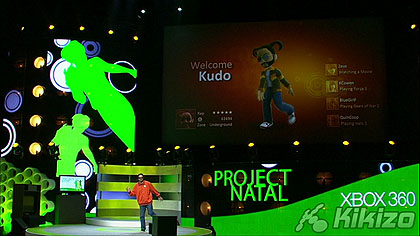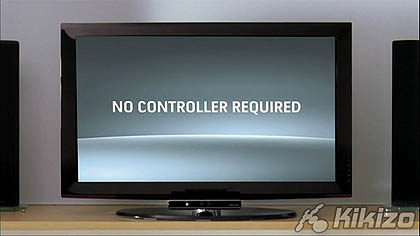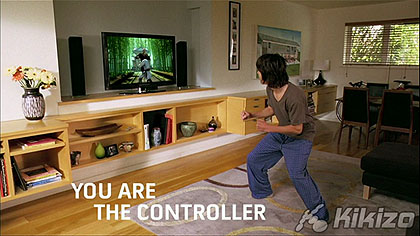First-Hand with Natal:
Why it's a Bigger Deal Than Critics Think
We present to you our info-packed, first-hand, behind closed doors impressions of Xbox 360's stunning new killer app, chat to Kudo Tsunoda and Peter Molyneux, and explain why some of its critics are really missing the point.
Page 2
But it's not magic, it's real; Kudo told me that it's actually some really smart infra-red 'radar'-like trickery that accurately perceives players in 3D space, simultaneously tracking over 48 joints on your body, enabling it to accurately redraw your skeleton in real time as you move about. On a separate 'debug screen' in the closed-doors session, we could witness for ourselves the 'mind's eye' of Natal, visually showing how it completely understands where we are, how we're moving, where we are in 3D space, how far in front of my face my hand is, whatever. It can supposedly even track individual hand and finger movement when it switches into this more finely-tuned mode.
I still don't really understand how this works just with infra-red technology and smart software - but it really does work. Back at the conference, I watched 'Ricochet' (the very rapid, fast-paced, player-smashes-bouncy-balls-back-at-destructible-blocks demo) with my own eyes, very closely, and noted its unfakable, highly responsive, 1:1 accuracy. And then at this private session, I was able to play it myself and confirm its authenticity; not only did it just work with no 'calibration' needed, but the experience of it is like nothing I've experienced in any type of game or entertainment before. There is a surprising feeling of tactility and iPhone-like fluidity and precision to the way Natal works, and I believe anyone who has a go on this will be instantly convinced.
This device also boasts face recognition and voice recognition, while its software has the ability to recognise what you are saying and how you are saying it, and calculate a response - as shown off in the Milo and Kate demo, which literally took my breath away when it was shown last Monday. With assistance from Peter, I later 'met' this simulated ten year-old boy myself, and after responding "hi, Adam" when I introduced myself to him, Milo complimented my choice of a blue shirt. I went on to tell him I'd had a pretty good week during E3, but that I had lost my iPhone the night before. His expression changed to be more empathetic. How is that even possible? Magic?
Again: it's not magic - it's real. Molyneux told me that this 'emotional AI' is actually something they've been working on for a long time (Project Dimitri was first mentioned in 2002!) and that when he saw Natal, he knew this was the perfect way to bring this "flagship technology project" (as he described it to us back in 2004) to life. The voice recognition software - which was actually developed elsewhere within Microsoft and apparently features in the upcoming Windows 7 - had detected the changing intonation in my voice when I mentioned losing the phone. Lionhead has programmed Milo to respond accordingly. I'm sorry, but anyone who doesn't think this is hugely impressive, I can't really convince any further about Natal.
So it's much, much better than the other motion-related products out there, plain and simple. It can do anything MotionPlus can do and so, so much more. How does all this relate back to critic point number one, which I'm aiming to debunk? Because the potential for Natal to offer new ways of playing traditional core game genres is not really debatable, nor is the scope for entirely new genres. It's for these reasons that the active/passive game argument is really kind of irrelevant in the grand scheme of things.
OK, so point number two, there is no release date in sight. Wii MotionPlus is here today. People are enjoying the latest version of Wii Sports and EA's Grand Slam Tennis on it, today. That's all well and good, but to echo point one, Natal is technology that is in a different league. It's like a whole generation ahead in console generation terms. Of course it's not out yet, but so what? This doesn't really count against Natal as a new technology, it just makes a rather obvious observation and if anything, underlines the fact that it's probably a lot more advanced because it was revealed 11 months after MotionPlus was.
On to the third thing. "I get it", people say, "but I don't believe it works". People have noticed glitches, right? And I heard it can't detect black people!
I'm going to jump right into to this "it can't detect black people" thing and tell you right now it's BULLSHIT. Not only can it detect black people, it can detect players perfectly even with the LIGHTS TURNED OFF. I saw this demonstrated in the private session: Kudo had the lights dimmed to almost zero, and the Ricochet demo continued, completely unaffected. You don't need to worry about ideal lighting conditions like with EyeToy. Natal does not track players by colour (although we know from Milo commenting on my blue shirt that it can if it wants to); it tracks them by infra-red - and it can track up to four people at the same time with no compromises.














 Satoru Iwata Video Interview - the late Nintendo president spoke with Kikizo in 2004 as 'Nintendo Revolution' loomed.
Satoru Iwata Video Interview - the late Nintendo president spoke with Kikizo in 2004 as 'Nintendo Revolution' loomed. Kaz Hirai Video Interview - the first of Kikizo's interviews with the man who went on to become global head of Sony.
Kaz Hirai Video Interview - the first of Kikizo's interviews with the man who went on to become global head of Sony. Ed Fries Video Interview - one of Xbox's founders discusses an epic journey from Excel to Xbox.
Ed Fries Video Interview - one of Xbox's founders discusses an epic journey from Excel to Xbox. Yu Suzuki, the Kikizo Interview - we spend time with one of gaming's most revered creators.
Yu Suzuki, the Kikizo Interview - we spend time with one of gaming's most revered creators. Tetris - The Making of an Icon: Alexey Pajitnov and Henk Rogers reveal the fascinating story behind Tetris
Tetris - The Making of an Icon: Alexey Pajitnov and Henk Rogers reveal the fascinating story behind Tetris Rare founders, Chris and Tim Stamper - their only interview? Genuinely 'rare' sit down with founders of the legendary studio.
Rare founders, Chris and Tim Stamper - their only interview? Genuinely 'rare' sit down with founders of the legendary studio. The History of First-Person Shooters - a retrospective, from Maze War to Modern Warfare
The History of First-Person Shooters - a retrospective, from Maze War to Modern Warfare